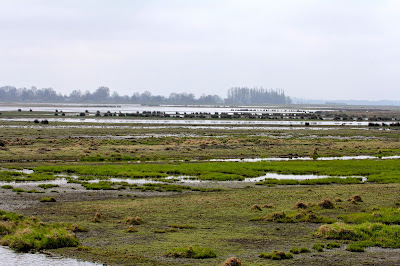When the tidal surge of December 2013 hit
Suffolk, 1.5 million cubic metres of water poured over the sea walls into
Havergate Island, flooding everything bar the tops of the hides and huts. It is widely acknowledged that the flooding
of the island saved other land around the estuary from a similar fate. Damage was severe to some parts of the walls
and it took a month or so to drain out the water to suitable levels. But ultimately,
the flooding caused very little damage to the ecology of the island and may
even have been beneficial. Under climate
change predictions, such events will increase in the coming years. So where do we go with Havergate in the
future?
Havergate Island used to be 'Avocet Island' but
although large numbers of Avocets still feed on the lagoons, very few now breed.
In recent years the complex of saline lagoons on the island have been
colonised by 1000s of pairs of Lesser Black-backed and Herring Gulls. Now, nice as large gulls are, they have the potential
to all but eliminate smaller 'seabirds' (gulls, terns and waders) by their
sheer density of occupation and their habit of predating the chicks. Whereas 20,000+ pairs of LBBG used to nest in the adjacent Orfordness, a rapid decline
to just a few hundred has occurred due to predation by Foxes and disturbance. Evidence from colour-ringed birds shows that
these displaced Orfordness gulls now nest widely. There were 2,070 pairs on Havergate in 2014.
Although the gulls may be squeezing out the Avocets, the island is still
favoured by Spoonbills and in other locations they are quite happy to nest
amongst large gulls.
The surge tide damage to the island has now
been repaired. The section of wall that was all but washed away has been re-built but is now slightly
lower and re-profiled. The aim is to
lower and re-profile further sections of wall and install more water control
sluices. The lowering and re-profiling
will allow future surge tides to flow in more smoothly without damaging the walls, so
will both reduce repair work and maintain the wider flood defence
benefits of allowing the island to flood.
The additional sluices will allow quicker discharge of the floodwater to restore optimum water levels. The island will be managed for wintering and passage waterbirds, breeding gulls,
Spoonbills and specialist lagoonal invertebrates such as the Starlet
Sea-anemone. But what of the displaced
Avocets?
On the ‘mainland’ of Suffolk the aim is to ‘roll
back’ and create new freshwater and brackish lagoon habitat behind the seawall. The project at Hollesley (as previously
described) is already highly productive for breeding Avocets and other
waders. New areas are also being planned
at nearby Boyton to add to the existing wet grassland habitat. The aim is to adapt to climate change, where
possible providing benefits both for wildlife and for people at the same time.
Photos: above: Havergate aerial, just after the surge, Avocets in a fluster.
Below: damaged sea wall, Starlet Sea-anemone, Hollesley aerial.
Photos: above: Havergate aerial, just after the surge, Avocets in a fluster.
Below: damaged sea wall, Starlet Sea-anemone, Hollesley aerial.

















